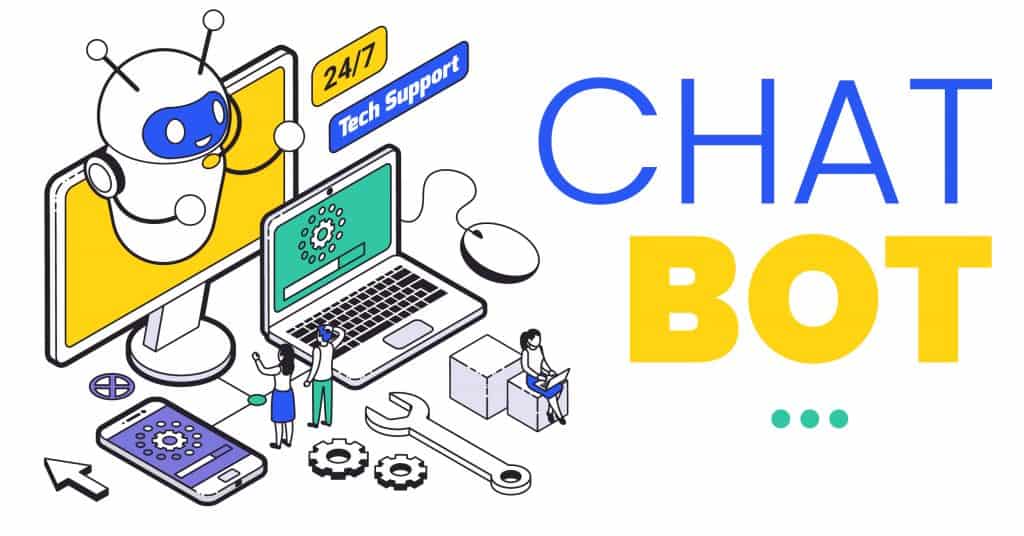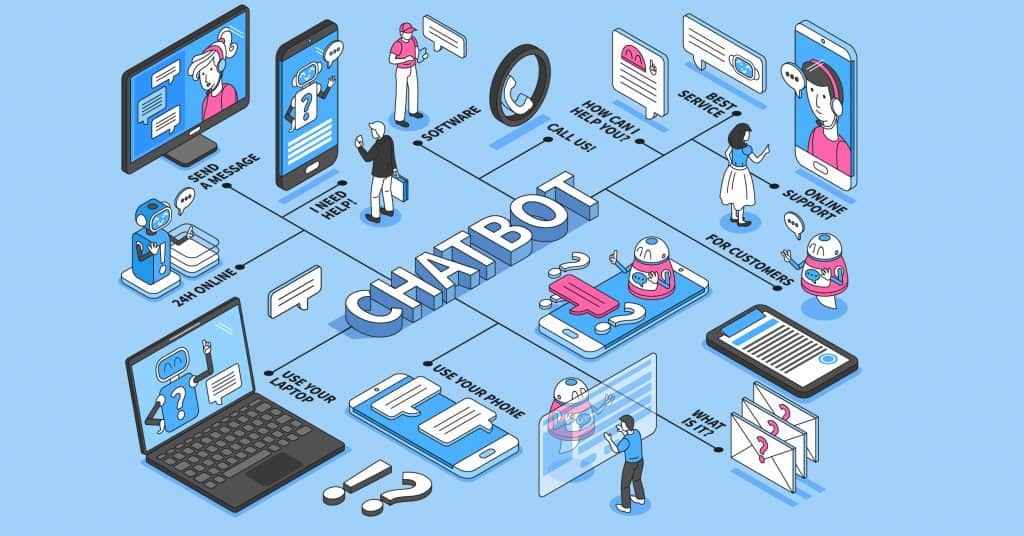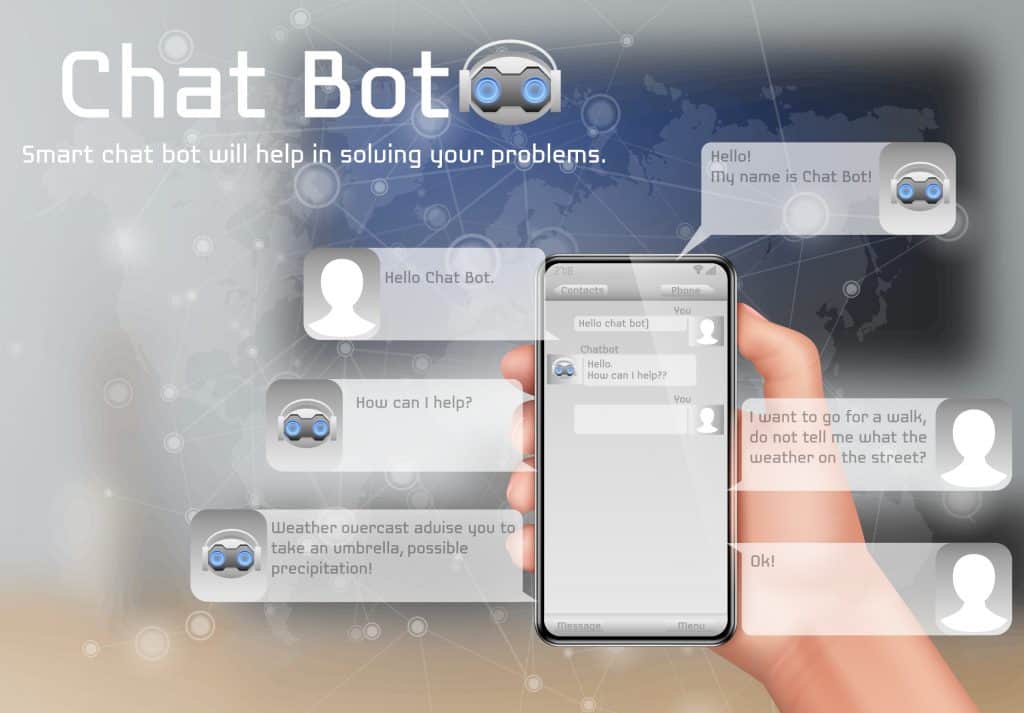FILL OUT THE FORM BELOW & ALLOW US TO TAKE YOUR Chatbot SERVICES TO A WHOLE NEW LEVEL!
Recently, new tools have been developed to facilitate communication between people and computers that have come to market: Chatbot services or Virtual Assistants. In the bank, chat rooms with real assistants are new tools in the industry designed to facilitate communication between people and computers.

What exactly is Chatbot?
A chatbot is an artificial intelligence (AI) software that can simulate a conversation (or conversation) with a user in the native language through messaging apps, websites, mobile apps or by phone.
Why are conversational discussions important? A chatbot is often described as one of the most advanced and most promising forms of communication between humans and machines. However, from a technical standpoint, Chatbot companies only represent the natural emergence of a questionnaire system that uses native Language processing (NLP). Creating answers to natural language questions is one of the most common examples of Indigenous language analysis used in various business applications.

How Does Chatbots Work?
There are two different tasks in the context of a conversation:
- User request analysis
- Return feedback
1. User Request Analysis
This is the first activity that a conversationalist does. Analyzes user request to identify user intent and exclude relevant items. The ability to identify a user’s intent and extract the relevant data and content contained in a user’s request is the first step and the most appropriate step in the discussion context: If you do not fully understand the user request
2. Return Feedback
Once the user’s intent has been reached, the customer service Chatbot must provide the appropriate response to the user’s request. The answer may be:
- general and predefined text;
- text from a database containing different responses;
- a piece of conditional information based on user data provided;
- data stored in business plans;
- the result of a chatbot action in response to one or more background applications; or,
- an incomprehensible question that helps the Chatbot to understand the user’s request better.
Why Chatbots are important
Chatbot applications integrate communication between people and services, improving customer experience. At the same time, they offer companies new opportunities to improve customer engagement and efficiency by reducing customer service costs.
To be successful, a chatbot development services must be able to perform both tasks successfully. Personal support plays an important role here: No matter what approach and speaker, human intervention is essential in establishing, training and implementing a chatbot system.

Which Chatbot app is right for you?
There are a variety of methods and tools you can use to create a conversation. Depending on the usage case you want to address, some chatbot technologies are more efficient than others. To achieve the results you want, a combination of various AI forms such as natural language processing, machine learning and semantic comprehension can be the best option.
In a future post, we’ll give you an overview of the main chatbot applications so you can evaluate them according to your specific needs and objectives.
Problems with General Online Customer Experience
As with any emerging technology, negotiations will be more widely accepted if it is shown that they can solve real problems. Otherwise, youth will eventually wear out.
So to better understand when the opportunity lies in chat conversations, we have asked our 1,000+ study participants to consider the online services they use today, such as search engines, messaging apps, product/service websites, and mobile apps.
The most common frustrations reported by consumers include:
- Websites difficult to navigate (34%)
- Inability to find answers to simple questions (31%)
- Basic information about the business address, business hours, and phone number – hard to find (28%).
Businesses online experience providers no longer match the way people like to shop. In the real world, lumbering elephants are exposed to the aggression of speeding midgets. When they don’t, they get frustrated, and they can end up turning to competitors who offer the kind of online experience they want.
Estimated Usage and Potential Profit
Now that we understand the key issues consumers face with traditional online experience let’s look at how to chat conversations (and how) solve these problems. Our research has provided a brief overview of how chatbots work and the types of jobs brands and businesses use.
We then asked our participants: What do you think you would use the chat for?
The most common predictable uses for reporting consumer chatbots include:
- Getting quick answers to questions in an emergency (37%)
- Resolve a complaint or problem (35%)
- For detailed answers or explanations (35%)
And you should be aware that 34% of consumers have predicted that they will use chat channels to have social conversations and social media.
There is a correlation between consumer concerns and their predictable usage cases for negotiations. Consumers want to be able to use chat conversations to generate information and get answers quickly and easily. And if the Chatbot development companies don’t have all the answers, consumers would like that chat to connect with someone.
Blockers to Wider Chatbot Adoption
Aside from the many uses and benefits consumers predict that chat chats will offer you, mass acceptance of chatbots is not an imminent end. Especially when you consider how new technology is, it is understandable that consumers will have some concerns. Therefore, we felt it was important to ask our study participants the following question: What can stop you from using Chatbot?
The most common blockers to use consumer reporting conversations that they report include:
- Preference (43%)
- Worry about a chatbot error, such as when shopping or booking (30%)
- Restricted use of chat only using messaging platforms such as Facebook Messenger (27%)
However, it should also be noted that 15% of consumers have said that nothing can stop them from using chat rooms. And that figure was consistent throughout the age group.
Not all consumers are willing to give up personal contact with anyone, and some are not convinced that they can trust technology to perform certain tasks without making mistakes. Also, if consumers only have access to a chatbot via a specific social network, that can be a barrier to finding children.
But here’s the thing: As a business, it doesn’t have to be either/or. You can use chatbot platforms to make sense (e.g. by providing quick answers to simple questions) and get people to intervene when needed.
Additionally, you do not need to rely on Facebook Messenger bots to give customers, and potential customers access to the Chatbot. These days, you can have conversations that work directly on your website, and you can use links to make it easier for people to start chatbot conversations from any social network.
Chatbots vs Other Communication Channels
While not all consumers are ready to trust chat chats entirely, most still agree that chat chats are ready to provide a few benefits to maximize what happens to them online. And it is clear that one of the biggest benefits consumers see when it comes to using chat conversations is speed: They believe that AI conversations and conversations will quickly answer their questions.
From a business perspective, there is a lot of tolerance in providing quick response times. As research from InsideSales and Harvard Business Review shows, even if you wait just five minutes to respond after a first lead, there is a 10x reduction in your disagreement with that lead. After 10 minutes, there is a 400% decrease in your leading eligibility criteria.
So as part of our research, we wanted to see how the expected response times of interviews compared to the expected response times of other communication channels. We asked: Can you expect to get a response soon from each of these social media channels?
Finally, consumers expected to receive faster responses to online chats than any other channel (77%), but chat chats came in a second-second (75%) and were followed by face-to-face meetings (73%).
Meanwhile, email (62%), landing forms (web) (52%), and social media (50%) were top channels when it came to waiting for answers within 24 hours, and the characters were far from the channel number when it came to waiting for answers after 24 hours (60%).
An online chat is a channel that most consumers expect a real-time response from. However, chatbots arrive in an instant – higher than face to face, phone or apps.
And here’s what to consider: As an ecommerce business, by using live chat by interacting with chat rooms, you can bring in response times and resolve issues faster than ever before. When online users, they can lead in responding to incoming conversations. But if the chat volume is too high, or if there are no employees online yet, chats can come in to help you so that your response times are less painful.
In addition to looking at response times, we also wanted to see how interview chats are compared to other traditional business communication channels in terms of tangible benefits. Specifically, we wanted to hone in on how to chat conversations compare to apps, email, and phone calls.
Chatbots in financial services are new apps, but they still have to eliminate the need for phone and email to contact businesses.
Customers select more app discussions in five of the ten categories we cover, including getting quick answers to simple questions and 24-hour service and getting quick answers to complex questions and getting detailed/expert answers.
When it comes to email, buyers also like conversations in sections related to instant response times (re: quick responses, 24-hour service). However, email had a clear edge when it came to getting detailed/expert responses.
And it is the same story when we look at comparative telephone interviews, although in this case, it is noteworthy that consumers also choose to use the phone to get quick answers to complex questions. Email and phone calls were also considered high in terms of ease of communication, registering complaints, and promptly resolving them.
One way businesses can create these visual bargaining channels: Have chat chats and give consumers the option to send an email or schedule a call if this is the way they would like to communicate. Because especially when you are faced with complex technical issues, getting into a phone call with an engineer may be the best option.
While chat chats have a lot to offer in improving the online experience, they can’t replace the personal touch.
Consumers nowadays need to be able to rapidly and conveniently locate the knowledge they need online. If a company is unable to offer that level of service, customers become dissatisfied. Chatbots are poised to alleviate these frustrations by offering the real-time, on-demand solution that customers need.
The top three possible benefits of chatbots as identified by consumers in our survey:
- Available 24 hours a day, seven days a week (64 per cent)
- Immediate reactions (55 per cent)
- Responses to basic questions (55 per cent)
This is true for people of all ages. Chatbots’ future advantages are not limited to Millennials. In reality, as compared to their Millennial peers, Baby Boomers were 24% more likely to predict benefits from chatbots in five of the nine categories we examined.
However, chatbots, like all other systems, have limitations: 43 per cent of customers said they prefer working with a live human (that was the number one potential barrier to using chatbots)—34% of customers expected that they will use chatbots to communicate with a person. As a result, it does not have to be either/or. Chatbots may be used by businesses to complement their human employees.
This is true for people of all ages. Chatbots’ future advantages are not limited to Millennials. In reality, as compared to their Millennial peers, Baby Boomers were 24% more likely to predict benefits from chatbots in five of the nine categories we examined.
However, chatbots, like all other systems, have limitations: 43 per cent of customers said they prefer working with a live human (that was the number one potential barrier to using chatbots)—34% of customers expected that they will use chatbots to communicate with a person. As a result, it does not have to be either/or. Chatbots may be used by businesses to complement their human employees.
Chatbot services have received a lot of attention lately. We see them as a tool that can help fill the differences between business contact networks and offer a stronger, faster online experience to customers.


